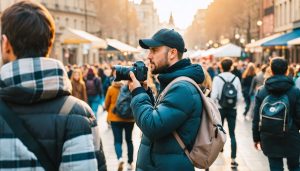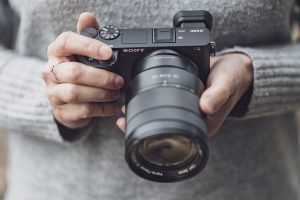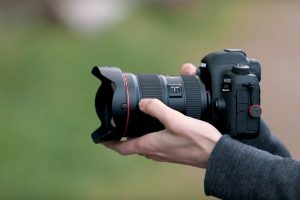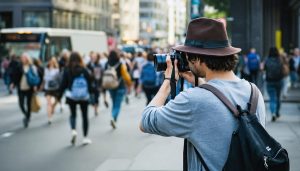
A photographer raises their camera on a busy street corner, and in that split second, they face a profound ethical dilemma. Street photography captures authentic human moments, but it treads a delicate line between artistic expression and personal public privacy rights. While legally protected in most public spaces, this raw, unfiltered documentation of daily life raises pressing questions about consent, dignity, and moral responsibility.
The debate intensifies as our increasingly connected world makes every captured image potentially viral, transforming fleeting moments into permanent digital artifacts. Street photographers must navigate complex terrain: preserving authentic human experiences while respecting individual autonomy, creating compelling art while maintaining ethical boundaries, and balancing artistic freedom with social responsibility.
Today’s street photographer faces unprecedented challenges. When does documentation become exploitation? How do cultural differences affect what’s acceptable? Where do we draw the line between public observation and private intrusion? These questions demand careful consideration from anyone wielding a camera in public spaces, as the answers shape not just our photographs, but our relationship with the communities we document.
The Legal vs. Ethical Landscape
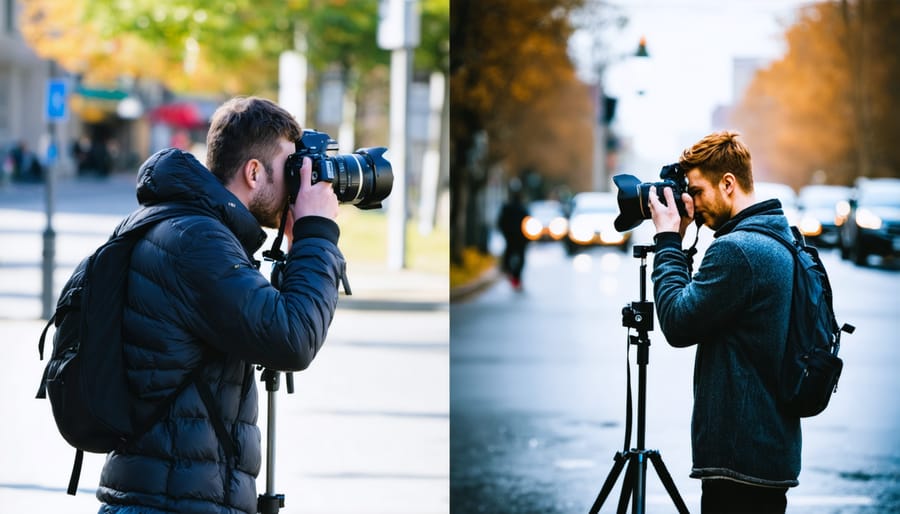
Legal Rights of Photographers
In most countries, photographers have broad legal rights when shooting in public spaces. The general rule is simple: if you can see it from a public place, you can photograph it. This includes streets, parks, and public squares where there’s no reasonable expectation of privacy.
However, these rights come with important limitations. While you can legally photograph people in public without explicit permission, certain uses of these images – particularly for commercial purposes – may require a model release. Private property owners can restrict photography on their premises, even if these spaces are publicly accessible, like shopping malls or privately-owned plazas.
Some locations, such as government buildings, military installations, or specific cultural sites, may have special restrictions on photography. It’s also worth noting that while something may be legal, it might not always be ethical – a distinction that responsible photographers should carefully consider.
Different countries have varying laws regarding street photography, particularly concerning privacy rights. Before shooting in a new location, it’s advisable to familiarize yourself with local regulations to ensure you’re operating within legal boundaries.
Subject Rights and Expectations
When discussing ethical boundaries in photography, we must consider the reasonable expectations of privacy that subjects have in public spaces. While legally, people in public areas generally don’t have a right to privacy, ethical street photography requires understanding and respecting certain boundaries.
In busy city streets or public events, most people expect to be seen and potentially photographed as part of the crowd. However, this expectation changes in situations where individuals might be in vulnerable positions or engaging in personal moments, even if technically in public view. For instance, someone sitting alone on a park bench crying, or a parent disciplining their child.
Consider how you would feel if the roles were reversed. Would you be comfortable being photographed in that particular moment? This empathy-first approach helps guide ethical decision-making. Additionally, be mindful of cultural sensitivities – what might be acceptable in one society could be deeply offensive in another.
Remember that just because you can take a photo doesn’t always mean you should. Respect for your subjects’ dignity should always take precedence over getting the perfect shot.
Ethical Considerations in Practice
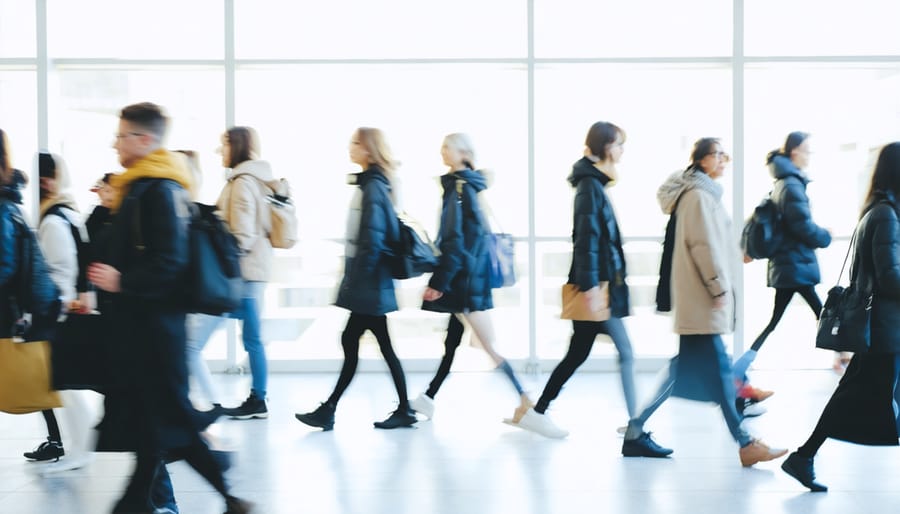
Vulnerable Subjects
When photographing vulnerable subjects, street photographers must exercise heightened awareness and ethical sensitivity. Children, elderly individuals, and people in distress require special consideration due to their potentially reduced capacity to consent or understand the implications of being photographed.
For children, always obtain parental permission when possible. Even if you’re legally allowed to photograph in public spaces, capturing images of minors without consent can raise serious ethical concerns and potentially cause distress to families. Consider photographing children from angles that don’t reveal their identities, such as silhouettes or from behind.
Elderly individuals, particularly those who may be confused or dealing with cognitive challenges, deserve extra respect and consideration. If you notice signs of discomfort or confusion, err on the side of caution and refrain from taking the photo. The same applies to individuals experiencing homelessness, mental health crises, or other vulnerable situations.
When encountering vulnerable subjects, ask yourself:
– Could this image exploit or demean the subject?
– Would I be comfortable if someone photographed my vulnerable family member this way?
– Does this image serve a meaningful documentary purpose, or am I simply seeking shock value?
Remember that ethical street photography should dignify its subjects, not exploit them. If you choose to photograph vulnerable individuals, approach the situation with empathy and ensure your work contributes positively to the broader conversation about social issues.
Cultural Sensitivity
Street photography across diverse communities requires a deep understanding and respect for different cultural norms and sensitivities. What might be perfectly acceptable in one culture could be deeply offensive in another. For instance, in some communities, photographing elderly people without permission may be considered disrespectful, while in others, capturing images of religious ceremonies or sacred sites might be taboo.
When photographing in culturally diverse neighborhoods or while traveling, take time to research and understand local customs and traditions. Pay attention to religious observances, cultural celebrations, and community practices. For example, some Orthodox Jewish communities might object to being photographed on Sabbath, while certain Indigenous communities may have specific beliefs about photography and spiritual ceremonies.
Building rapport with local communities can make a significant difference. Consider engaging with community leaders or cultural organizations before extensively photographing in their area. This not only shows respect but can also lead to more meaningful photographic opportunities and stories.
Be particularly mindful of vulnerable populations and marginalized communities. Avoid perpetuating stereotypes or creating images that could be misconstrued or used to harm the community’s reputation. Remember that as a photographer, you’re not just creating images – you’re documenting human experiences and stories that deserve to be told with dignity and respect.
Ultimately, cultural sensitivity in street photography isn’t just about avoiding offense; it’s about creating meaningful connections and representing communities authentically and respectfully.
Digital Age Implications
The digital age has dramatically transformed street photography, bringing new ethical challenges to the forefront. Social media platforms have created an environment where images can go viral within hours, potentially exposing subjects to unexpected and unwanted attention. What might seem like a harmless candid photo on the streets of New York could reach millions of viewers worldwide, raising questions about privacy in an interconnected world.
The immediacy of online sharing has also changed how we approach consent. While traditional street photography might have seen limited exposure in galleries or print publications, today’s digital platforms offer unprecedented reach and permanence. This shift demands photographers to consider not just the immediate impact of taking a photo, but its potential long-term digital footprint.
Another significant consideration is the rise of facial recognition technology and metadata. Photos shared online can contain detailed information about location, time, and even the identity of subjects through AI-powered recognition tools. This technological reality adds another layer of responsibility for street photographers to protect their subjects’ privacy.
The digital age has also fostered important discussions about representation and cultural sensitivity. Social media has given voice to communities who can now directly express their feelings about being photographed without consent, leading many photographers to reassess their approach to street photography in different cultural contexts.
Balancing Artistic Freedom with Respect
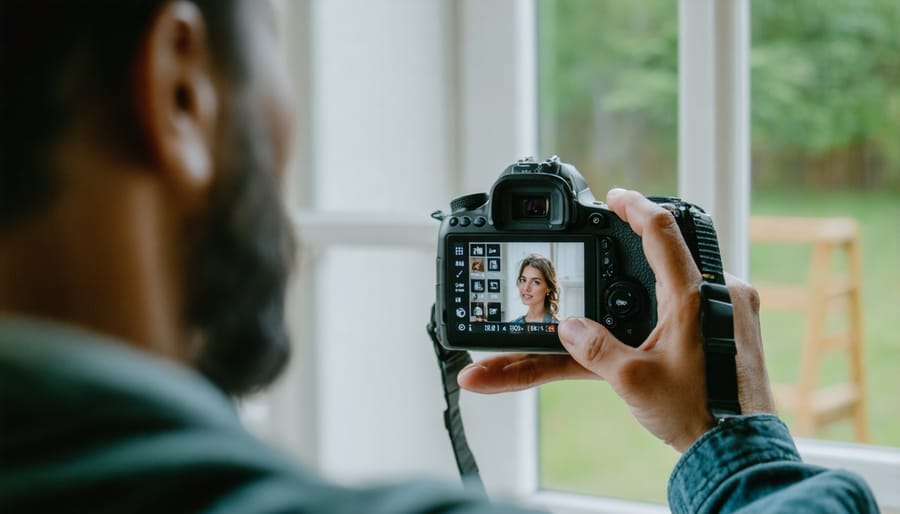
Obtaining Consent
Obtaining consent in street photography exists on a spectrum, ranging from candid shots taken without interaction to fully posed portraits with explicit permission. While it’s not always necessary or practical to ask for permission before every shot, building trust with subjects often leads to more meaningful photographs and positive experiences.
When approaching potential subjects, timing is crucial. Wait until after capturing a candid moment to introduce yourself and explain your intentions. A simple smile, friendly wave, and brief explanation like “Hi, I’m a photographer documenting city life. I just captured a lovely moment of you. Would you mind if I keep the photo?” can go a long way.
If someone refuses, respect their decision immediately. Delete the photo in their presence if they request it, and thank them for their time. This helps maintain the reputation of street photographers and shows respect for individual privacy choices.
For close-up portraits or extended shooting sessions, always obtain explicit consent beforehand. Consider carrying business cards or a small portfolio to establish credibility. Some photographers even offer to email copies of the photos to their subjects, creating a mutually beneficial exchange.
Remember that body language can indicate discomfort before verbal rejection. If someone appears uncomfortable or actively avoids your camera, take that as a silent “no” and move on to other subjects or scenes.
Reading Body Language
Body language speaks volumes in street photography, and learning to read these non-verbal cues is crucial for ethical practice. When someone spots your camera and turns away, crosses their arms, or hurriedly changes direction, they’re clearly communicating discomfort. These signals should be respected as firmly as if they’d verbally said “no.”
Watch for positive signals too. Sometimes subjects may make eye contact and smile, indicating potential openness to being photographed. However, never assume this alone is consent – it’s merely an invitation to potentially engage further.
Pay special attention to defensive postures like raised hands, ducked heads, or attempts to shield faces with objects. These are unmistakable signs that your subject doesn’t want to be photographed. In crowded areas, look for people who actively try to move out of your frame – this physical distancing is a clear message.
Cultural differences also play a role in body language interpretation. What might be acceptable in one culture could be deeply offensive in another. For instance, in some societies, direct eye contact might be considered confrontational rather than engaging.
The key is developing situational awareness. If you sense tension or discomfort, lower your camera and move on. Remember, getting the shot isn’t worth causing distress to others. By respecting these unspoken boundaries, you’ll not only practice ethical photography but also help maintain public trust in street photographers.
Post-Processing Ethics
Post-processing in street photography carries its own set of ethical considerations that extend beyond the moment of capture. While digital editing is a standard part of modern photography, maintaining authenticity is crucial when documenting real-life moments and subjects.
The general consensus among street photographers is that basic adjustments like exposure, contrast, and cropping are acceptable and often necessary to convey the intended message or mood. However, significant alterations that change the fundamental truth of a scene – such as removing or adding elements, dramatically changing colors, or heavily manipulating subjects’ appearances – can cross ethical boundaries.
Consider the impact of your edits on both your subjects and your viewers. Minor retouching to protect someone’s privacy (like slightly blurring identifying details) might be ethically sound, while major modifications that misrepresent reality or manipulate context would be problematic.
When publishing street photographs, transparency about your post-processing approach helps maintain trust with your audience. If you’ve made substantial edits, consider acknowledging them in your caption or description. Some photographers choose to include their editing philosophy in their artist statements or website policies.
Remember that street photography’s power often lies in its ability to capture authentic moments of human life. While post-processing can enhance your images, it shouldn’t compromise the fundamental honesty that makes street photography compelling and meaningful.
Street photography’s ethical landscape requires careful navigation, balancing artistic expression with respect for human dignity. Throughout this exploration of ethical principles in photography, we’ve seen how responsible practice enriches both our art and our relationship with our subjects.
The key to ethical street photography lies in maintaining a mindful approach. Always consider the impact of your presence and your photographs on others. While legal rights often protect photographers, ethical consideration should extend beyond mere legality. Respect, empathy, and cultural sensitivity should guide your decisions in the field.
Remember these core principles as you pursue street photography:
– Prioritize human dignity over getting the perfect shot
– Be transparent about your intentions when approached
– Exercise additional caution when photographing children, vulnerable individuals, or private moments
– Consider the cultural context and local customs of your shooting location
– Be prepared to delete photos if asked, even when not legally required
– Use your judgment to determine when seeking explicit permission is appropriate
The future of street photography depends on practitioners who understand and embrace these ethical considerations. By treating our subjects with respect and consideration, we not only create more meaningful work but also help preserve the practice for future generations of photographers.
As you develop your street photography practice, let these guidelines serve as a framework rather than rigid rules. Each situation is unique, requiring thoughtful consideration and quick decision-making. Trust your instincts, but always err on the side of respect and compassion.
Remember that ethical street photography isn’t about limiting your creativity – it’s about enhancing it through mindful practice and genuine connection with your subjects and their environments. By embracing these principles, you’ll create more meaningful and impactful images while contributing positively to the photography community.

